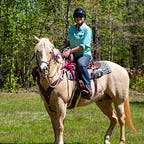A Perfect Animal
Celebrating the greatest creature of all time
We’re a dog family. Right now, I’m sharing a couch with six pooches. Every time my husband Joe walks by six heads rise, 12 ears prick, 12 eyes sparkle. Then all gazes turn to me. “Will she get up?” they seem to ask before Joe disappears into the next room. Satisfied that our couch lounging will continue, they lower their heads, relax their ears, and close their eyes. I am distracted by their charm. Dogs are, hands down, my favorite animals.
It’s almost Thanksgiving as I write, and when this column goes to print it will be Thanksgiving Day. While the research supports a hypothesis that gratitude is not only nice but beneficial to our mental and physical health, I don’t need a day set aside to give thanks for dogs. Every day of my life I am overwhelmed with gratitude for the spark that kindled this beautiful friendship some 30,000 years ago.
That spark was likely lit by members of a species of wolves, now extinct, who overcame their fear of hunter-gatherers to scavenge bones and other tasty left-behind morsels. What happened next? The story that wolf-pups might’ve been captured and raised by these early ancestors has been debunked. Among other things, anthropologists assure us that life was too difficult for people to opt for bringing in yet another mouth to feed.
It’s far more likely that women were responsible for building what has become a sacred trust. As strong, hungry wolves began following men out on the hunt, the younger and/or weaker wolves stayed behind with the women. A gentle look here, a kind word there, and bonds were formed. The wolves who had stronger connections with women were more likely to be accepted in daily life.
Over time both humans and wolves changed, and here we are, sitting on the couch together tens of thousands of years later.
The evolution of humans and dogs is considered “coevolution,” a situation in which two distinct species develop adaptations that benefit one another. Pollinators and flowers is the classic example, with the resulting relationship characterized as “commensalism,” or mutually beneficial.
What exactly are these friendly beasts beside me now? Are they little wolves? Although the same species, Canis lupus, dogs are not simply tame wolves. Canis lupus familiaris, domesticated dogs, are one of over 30 subspecies of the gray wolf. We often say, “Dogs are descended from wolves.” It is helpful to think of this path as a divergent branch rather than a hierarchal line.
Unlike wolves, dogs are capable of initiating and holding eye contact with humans. This may seem trivial, gazing lovingly into the eyes of one another, but in fact it produces the hormone oxytocin, nicknamed “the love hormone,” in both humans and dogs. In a beautiful open-feedback loop, dogs also produce more oxytocin in response to the smell of human oxytocin, and the gazing cycle continues. Be careful not to fall down the rabbit hole of research on “The Dog-Human Gaze.” You might miss Black Friday.
Dogs have developed facial muscles not found in wolves which enable them to make “puppy dog eyes.” This precious expression benefits the survival of the species, with humans responding favorably to cute faces. Additionally, dogs have rounder eye sockets, shorter snouts, and floppier ears than wolves. Therefore, dogs are actually “domesticated” wolves, which means they have undergone genetic changes which distinguish them from one another.
Sometimes in moments of utter contentment, like right now with these six dogs, it feels like the history of life on this planet has conspired to lead to this exact point. Hallelujah! In fact, we’re here due to random mutations coupled with natural and artificial selection for favored traits, and although this moment seems like the pinnacle, all those actions are still at work. Both humans and dogs are still coevolving, our behavioral and physical adaptations leading the changes.
I could write a world of words about all the ways dogs are being trained to detect this and that to the benefit of humanity, and the research behind companion dogs for personal and institutional benefits, but my dogs would tire of this. They are all gazing at me now, and I must stop writing and return the gaze. I have no choice. It’s biology.
Before I go, I must give a shout-out to the dogs with whom I have shared a home: Nick Dog, Abagail, Bowzer, Ziggy, Boo, Ugly, Gruff Chester, Ricky, Waldo Pepper, Otis, Pee Wee, Garth, Kennerly Punk, Lucy, Phoebe, Houndy, Poodle, Fidel, and Che; to our current pack: Lola, Peedie, and Bernie; to our grandpups Flea, Pru, Fig, and Tulip; to Susie and Ice, the cousin dogs; and to all the dogs everywhere. Thank you for making the world infinitely better.
And to the humans, Happy Thanksgiving to you all!
Mary Dansak is a writer and a retired science education specialist living in Auburn, AL. She can be reached at maryfdansak@gmail.com.
This essay originally appeared as a column in The Auburn Villager on 11/24/22.
